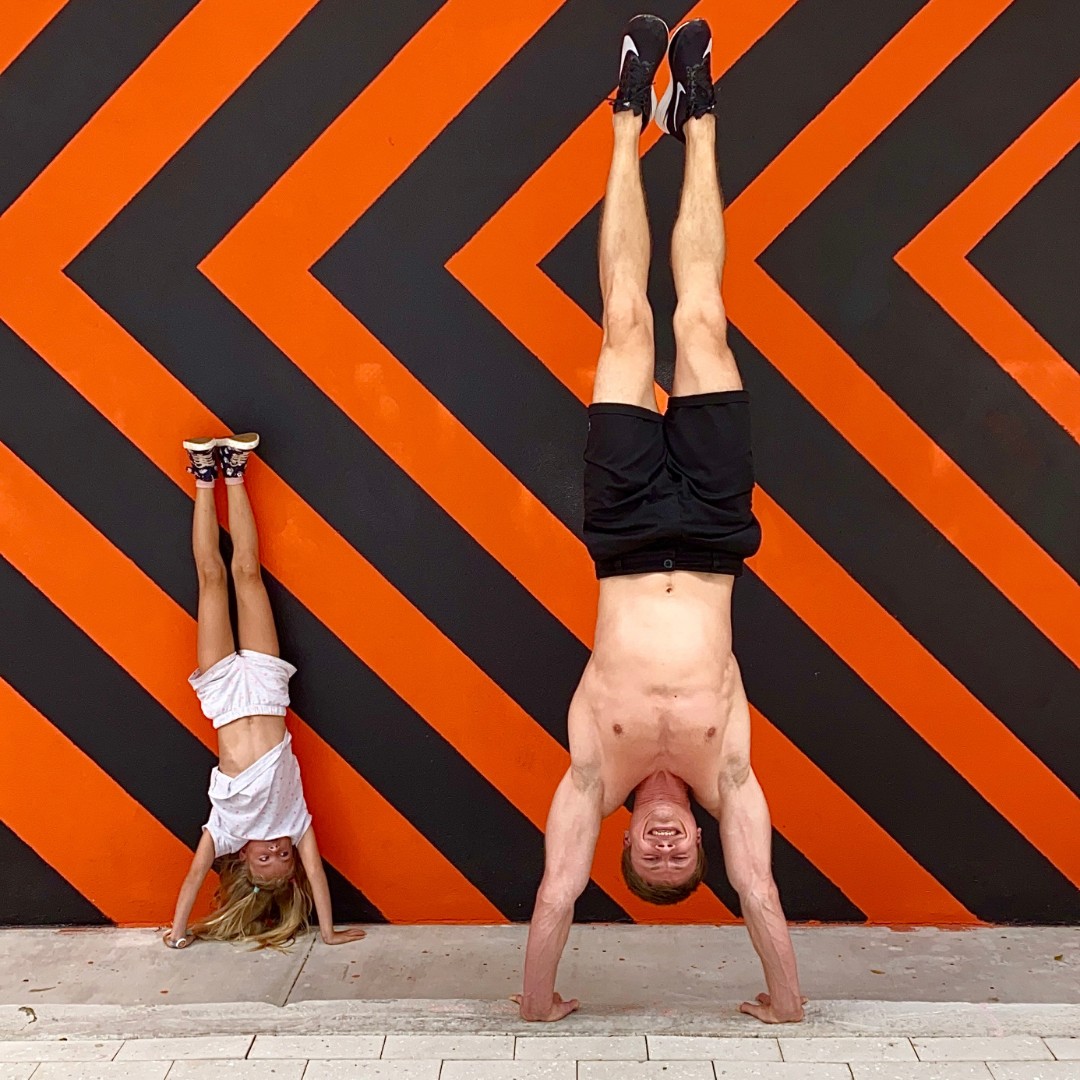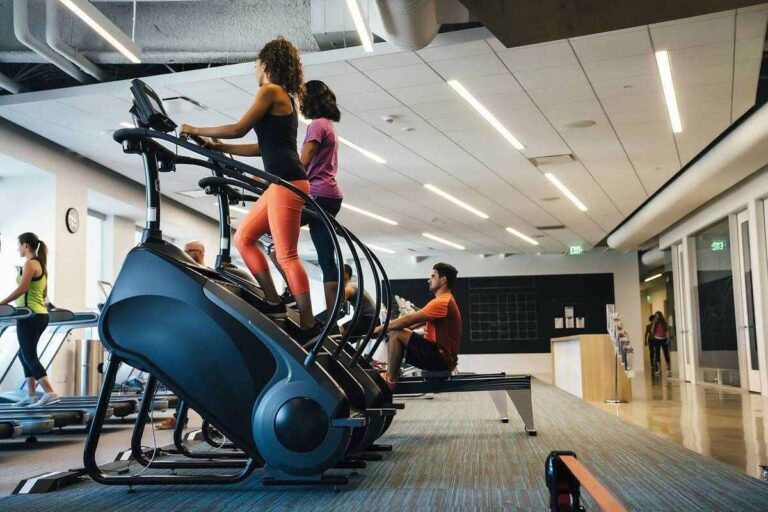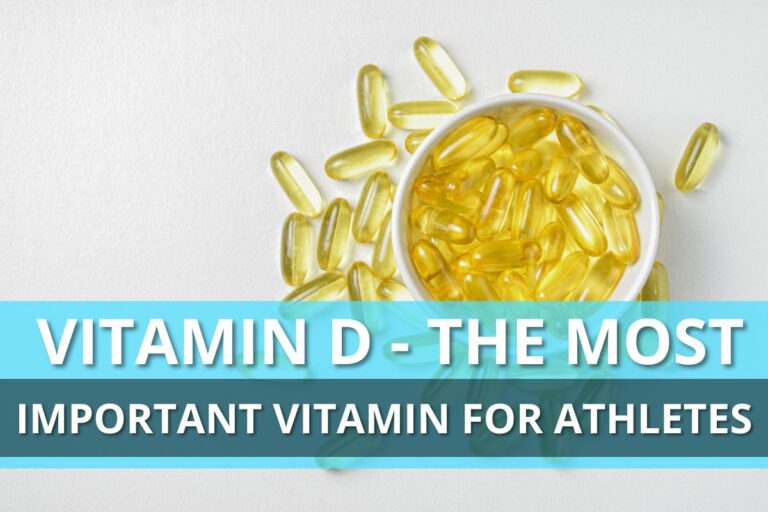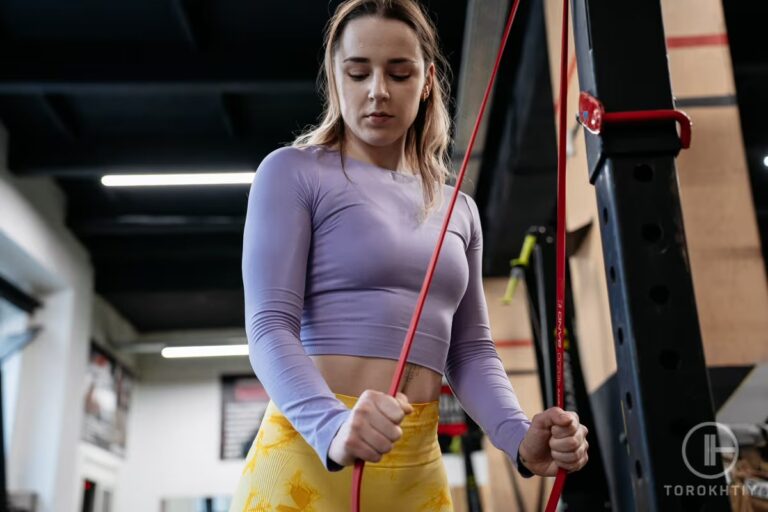10 Handstand Benefits: Wonders, Woes, and Ways of Training Upside-Down
Handstands bring a wealth of aesthetic value. Hoping up on your hands, balanced and composed, is an impressive feat. However, it’s more than a cool party trick. The health and wellness perks of this glorified pose are often downplayed. So, we’ll discuss science-based handstand benefits. You’ll also know exhaustive prep and progression tips by the end of the article.
Sneak Peek: Research shows four types of must-do exercises – viz., endurance (aerobic), strength, balance, and flexibility. Don’t conjure up a drawn-out gym routine because upside-down training checks each box within minutes!
What are handstands good for? Major handstand benefits include a permanent boost in your upper-body strength and mind-body coordination. The key to avoiding injuries is gradual progression and sufficient prior training.
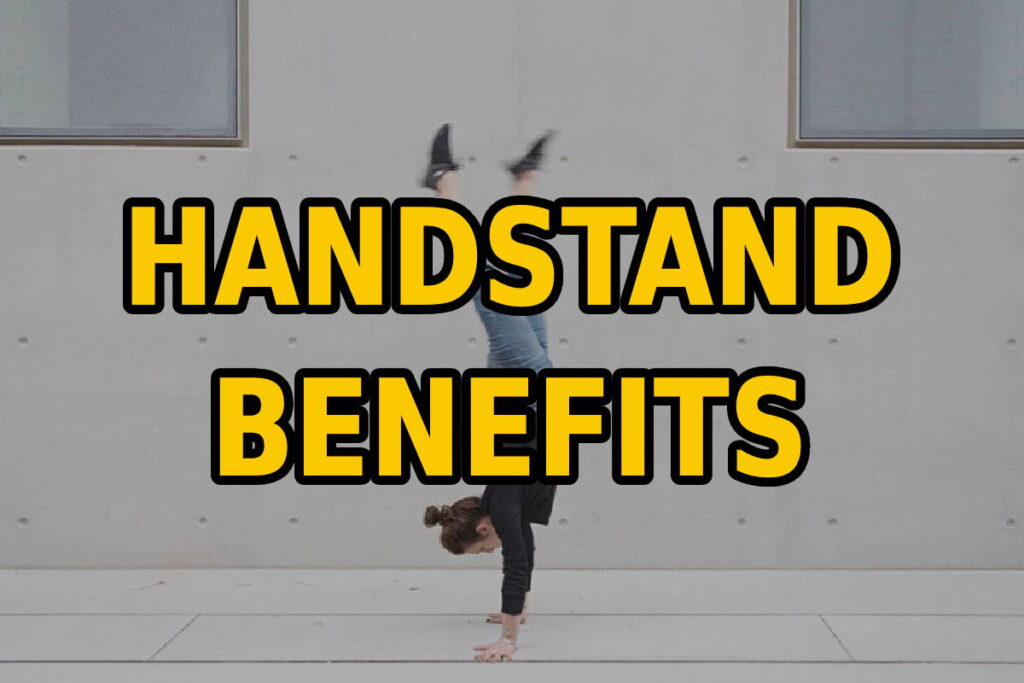
10 Wonderful Benefits Of Handstands
There are many handstand benefits for your physical and mental well-being, whether you kick up against a wall or manage to do freestanding ones. In addition to the no-equipment nature, handstands are time-efficient and adjustable for all skill levels. Integral to gymnastics and yoga asanas – the pinnacle calisthenics movement deserves a spot on your fitness bucket list.
1. Upper-Body Strength
People often associate push-ups and planks with upper-body workouts. You feel the burn, but not to the extent handstands put you through. Your entire body weight rests upon your shoulders, arms, and wrists. The upper back and chest also open up. That is the challenge! It’s a proven hypothesis that the strength of upper-body muscle groups is a limiting factor for balancing a difficult static position where the handstand belongs. As you get closer to ace it, you’ll develop unparalleled strength and stability.
2. Balance
You must know handstand practitioners excel at brawn as well as balance. The center of gravity naturally exists about an inch below the belly button. As soon as you flip into the inversion, it changes its position further down the body, making balance difficult. Now, your wrists and shoulders are equivalent to ankles and hips. In order to maintain the posture, you have to make small and continuous weight adjustments. Thus, you’ll see your power and balance skyrocket at the journey’s end.
3. Body Awareness
Are handstands good for you? After all, nobody walks on hands, so what’s the hype? Doing so polishes your motor skills, spatial awareness, and proprioception, which ultimately helps with everyday tasks and sports performance. It also opens doors to more advanced, gravity-defying acrobatic skills. Practicing handstands create full-body tension. It moves you in a harmonious and coordinative manner. Researchers have developed a special sensing board to master body awareness and balance during handstands.
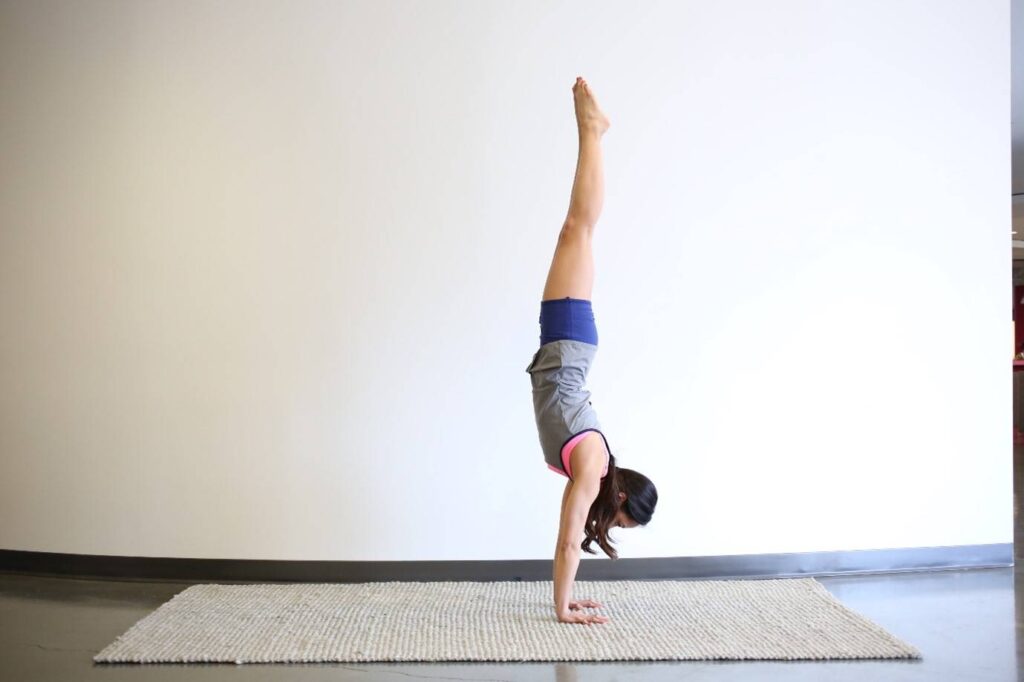
4. Stress Relief
With time, you’ll transform from a confused beginner to a calm yogi. The mental health benefits of handstands can outweigh the physical ones. You’ll feel calmer and happier. It’s because standing upside-down promotes blood flow to the brain. Meditative exercises are already known to spike blood flow to the frontal lobe, combating stress and depression. Observing from another dimension, the reduced level of stress hormones (cortisol) also helps with the antidepressant and mood-elevating effects of the exercise.
5. Core Conditioning
Do handstands build muscles? First of all, the strength of muscle fibers boils down to the produced force, not showcased size. If you’re seeking a functional move, handstands are unbeatable. Harvard Health recommends ‘bracing’ for core conditioning, which means tightening abdominal muscles as if preparing to take a punch. That’s what you do with planks, crunches, and handstands. In fact, what muscles do handstands work? Besides the upper body, you’re working up your abs, obliques, glutes, and psoas muscles as well.
6. Flexibility
From wrists to hips to ankles, hyper flexibility is one of the critical factors determining the quality of your handstand holds. Improvements in flexibility can reduce explosive strength requirements by freeing up gymnasts to assume mechanically advantageous body posture and alignment. They also increase your range of motion. The lack of elasticity stiffens muscles, exposing them to a greater risk of injuries. Doing proper handstands is a surefire and fun recipe for maintaining flexible muscles in the long term.
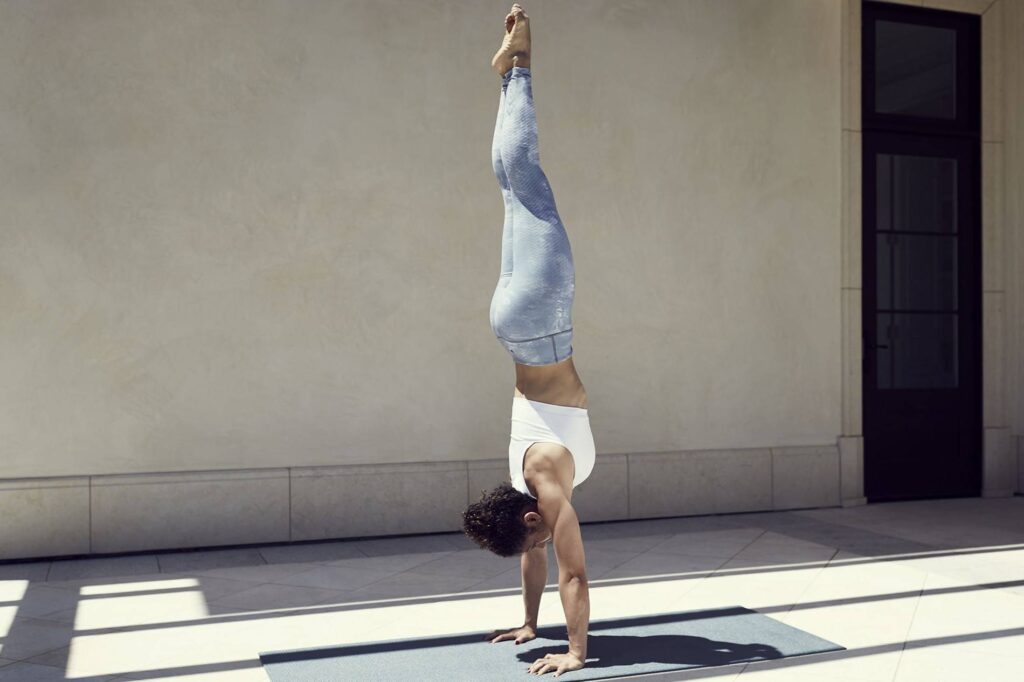
7. Blood Circulation
Staying inverted promotes cerebral blood flow. It doesn’t only stimulate brain functions; the circulation of important gasses and nutrients performs efficiently throughout the body. It gives resilience against diseases. Inversion therapy revs up your heart rate and dials down blood pressure. Cardiovascular handstand benefits aren’t stellar, especially when put against running or cycling, but should be researched more extensively. The American Council on Exercise estimates a one-hour gymnastic sesh to burn 288 calories for a 155 lb person.
8. Lymphatic Drainage
Blood doesn’t monopolize the complex network of your veins and vessels, a watery fluid called lymph also traverses back and forth. It returns excess fluid to the bloodstream. Immunity, digestion, and waste disposal are among the main tasks of the lymphatic system. Inversions benefit four systems: cardiovascular, lymphatic, nervous, and endocrine. The endocrine system is made up of glands that create and release hormones. These chemicals dictate all bodily functions, from growth and metabolism to emotions and sex life.
9. Bone Health
The study examining the relationship between exercise, osteoporosis, and bone geometry found that gymnastic, jumping, and sprinting athletes had a higher bone mineral content than non-athletes. Can you guess any reason? Well, mentioned disciplines (and handstands, likewise) are weight-bearing and muscle-strengthening exercises. They build bone density, retaining and regaining bone health. If you’ve had a skeletal fracture or disorder, consult a physical therapist since certain poses may not be safe for you.
10. Anti Aging
The scientific community agrees upon handstand benefits. However, there was no follow-up study to prove long-term miraculous effects until a Chinese man, 66, turned up. He had been flipping on his head for 40 years. His cerebral vessels and spinal discs were healthy, with youthful skin and a sharp mind, approving that handstands delay signs of aging. If you can crack the technique and progress to a stable stance on your hands, you’ll reap infinite benefits all your life without grinding through weights and machines for hours on end.
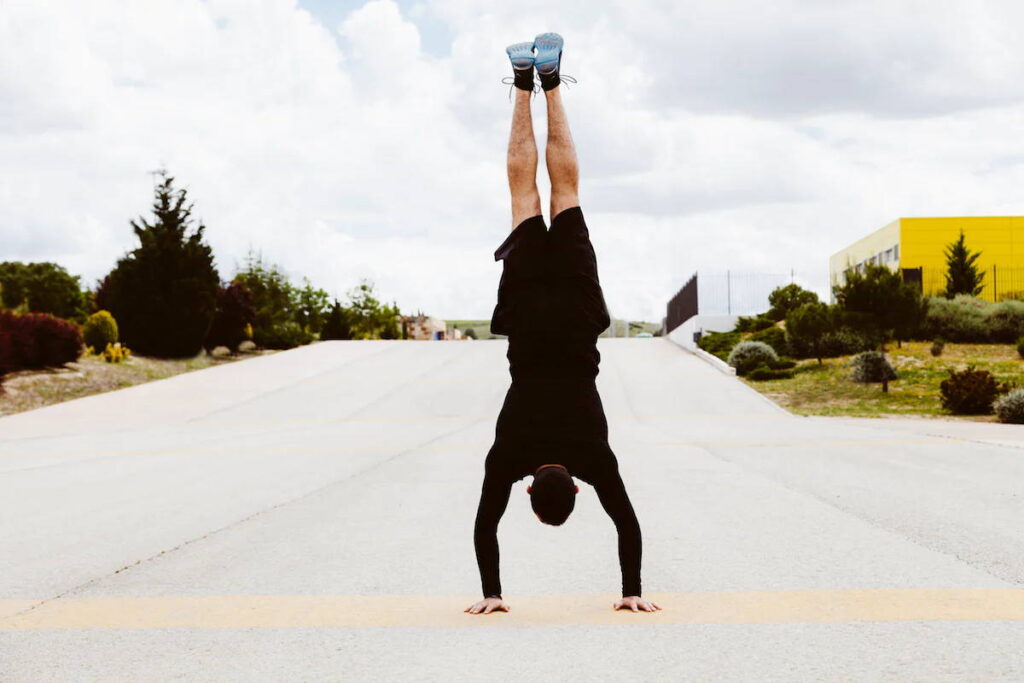
3 Possible Side-Effects And Risks Of Handstands
Returns and risks go hand in hand, especially when you groove on advanced-level moves. The best you can do is stick to the form and plan. Better yet, consult your doctor. Experts mostly avoid recommending handstands or headstands if you have bone and joint problems, hypertension, or glaucoma.
Following are some potential handstand disadvantages that have been touted over the years.
1. Injury Risks
A 10-year profile of collegiate gymnasts indicated an injury rate per 1000 exposures to be 8.78 and 9.37 for men and women, respectively. Hands, wrists, elbows, feet, and ankles are most commonly injured. The rate significantly varies according to skill level, sex, and age. In comparison, injury incidence for general calisthenics is only 1.28, and for weight training is below 4.4.
2. Neck Pain
Feeling a burning or tingling sensation in your neck, shoulders, and arms appears to be a natural phenomenon, given the position you take during handstands. However, it shouldn’t linger till your next session. Lack of upper-body strength puts excessive pressure on your intervertebral discs. A study on inversion traction risks spelled out falling on the head a fatal blow to the spinal cord.
3. Vision Loss
A handful of cases have reported vision loss and blurring. It’s understandable, given the high volume of blood gushing through your brain. For example, a 15-year-old boy was diagnosed with retinopathy and hemorrhage in his left eye. A fitness influencer shared her story on IG in 2019, telling how she got a stroke due to a carotid artery tear and extreme neck movements.
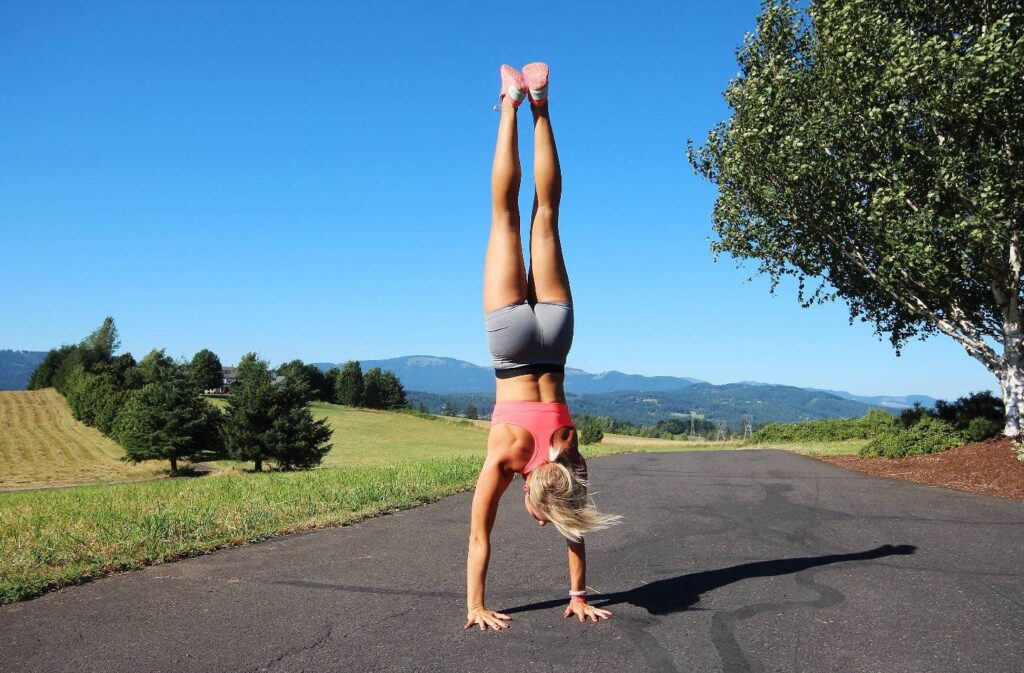
How To Do Handstands?
Handstand isn’t a mission impossible. It may take a little longer than usual to master and extend the hold. But you can do it in three simple steps.
Step 1: Kick-Up
When you’ve found a perfect spot to do handstands, the first thing is to kick up. Start with your dominant leg. Lunge a bit forward. Don’t lock the knee. And remember using your hands to resist gravity. They should be overhead and then follow a natural downward trajectory toward the ground. Beginners often hold back their legs to not fall over their heads. You must kick your non-dominant leg to an outright vertical before bringing the other one in line.
Step 2: Hold
How long you hold your handstands is what really matters. Follow two techniques: stacking and weight-shifting. The entire body, from wrists to shoulders to hips and ankles, must be in a straight line like Jenga blocks stacked up against each other. You’d surely feel sways and shakes. Dig in your fingers, and use them to uphold the alignment. Palms should distribute the load. Standing on your wrists primarily will keep you unstable.
Step 3: Fall
Launch and fall are as crucial for handstand benefits as the graceful hold. You can learn to bail before other steps to overcome the fear of falling. Consider it a rewind of your kick-up. Keep hands planted as you bring the dominant leg to the ground. The other one will again follow suit. Your legs would squeeze together the last and split the earliest. Finish standing with your arms still tucked near your ears, such as a spinning cartwheel.
Precaution And Progression
You need a certain degree of strength and mobility beforehand. Perhaps, you don’t have enough stretch in your upper back. Flexing wrists to a 90-degree can also create issues. Similarly, weak shoulder blades and rotator cuffs will fail to elevate under body weight. On the other hand, core and glutes engagement is of paramount importance.
You may have to exercise different body parts before being able to click Instagram-worthy handstands. A therapist can customize a workout plan. Our blog about extending the duration of handstands might be of help.
Another factor you should take into account is the gradual progression to a freestanding hold. First, do them against a wall. Practice wall walk and L-pose. Then, grab a spotter if you can. Having a soft floor underneath with mats or pillows would assure you to go all out. The point is to take things slow and listen to your body. This way, you’ll minimize risks and side effects to zero.
Benefits Of Handstands For Children
Most of us have attempted (and rather failed) handstands growing up. Handstand benefits aren’t age restricted. Babies are mostly nourished head-down in their mother’s womb. Hence, the inverted position is natural and fearless during early years. Besides the playful and daring nature of a child, a young body is more adaptable to flexibility and rhythmic drills. Children involved in the training have a high bone density and long-lasting benefits, even after years of retirement. Gymnastics also increase motor and movement skills. It may have growth, intelligence, and maturity gains – although contested, proposed contraindications have been disproved several times.
Handstand is the cornerstone of advanced gymnastic and acrobatic moves, such as walkovers and handsprings. Learning them initially will ensure you have a seamless career ahead. They even masquerade as Kip handstands and Yushchenko in the Olympics. Those “start here, go anywhere” slogans make sense now, don’t they? More importantly, it is a fun way to push kiddos toward an active and healthy life.
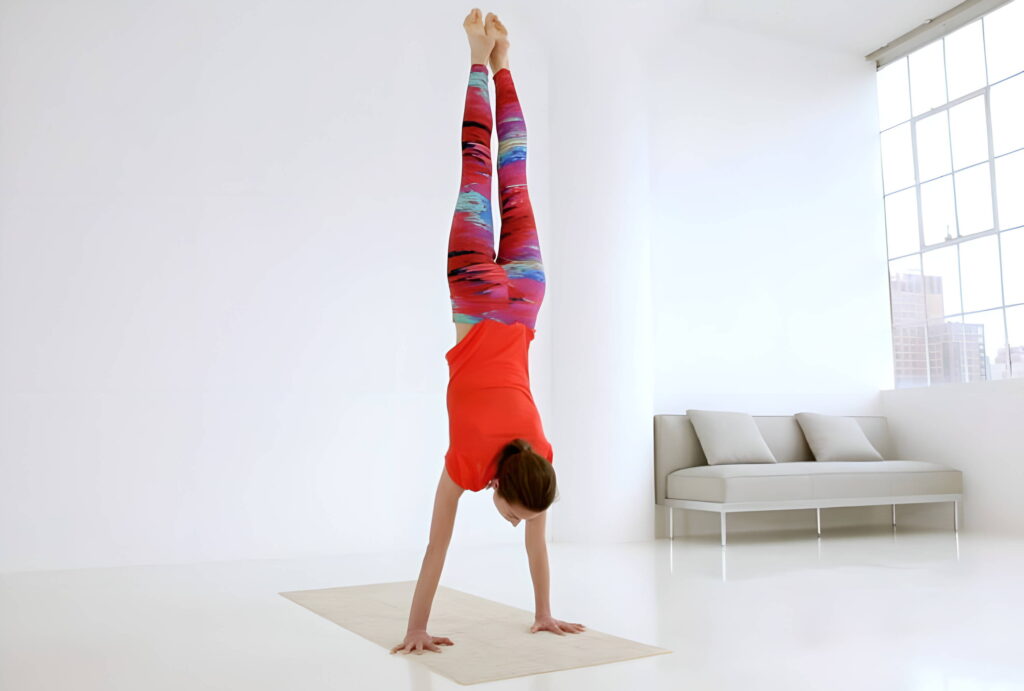
🔻21-DAY HANDSTAND CHALLENGE
Master Your First Handstand in 21 Days!
This program will help you to:
- ✅ Perform the Handstand Without a Wall
✅ Overcome Your Fear
✅ Master the Technique of Entering the Handstand
✅ Strengthen Shoulders and Core Muscles
✅ Improve Coordination, Balance, and Stabilization
✅ Have Fun: Enjoy the process
☀️Designed by a Cirque du Soleil Artist, Exclusively for You. Use it!
FAQ
Is It Good To Do Handstands Every Day?
Handstand is one of the few total-body exercises you can do daily. Balancing on hands is a trick like juggling. The more you do, the sooner you perfect it! However, there is a strength factor involved. And your muscles would fatigue after some time, leading to overuse and other injuries. Therefore, customize reps and intervals according to your fitness level. It may go from three times a week to the same or more in a day.
Are Handstands Good For Your Brain?
Handstands replenish blood flow to the brain and reduce stress hormones. It equips you to fight depression and feel happier, calmer, and fuller. Moreover, your mind-body coordination gets up a notch.
How Long Is It OK To Do A Handstand?
As long as you can, no pun intended! Your shoulders and arms would tell you when to stop. Generally, a 10-20 second hold is good for beginners, whereas over a minute-long stay in the air is remarkable for each rep.
Do Handstands Make You Stronger?
Sure! Handstands are pretty tough for your shoulders, arms, and chest. After all, they’re taking the stabilization responsibility from a much stronger lower body. Your core and glutes are also engaged throughout the movement. The tension has to be maintained from wrists to ankles to align properly.
Conclusion
Practicing handstands feel like a cheat day from an intensive gym regime. However, handstand benefits rival all brands of strength training in a short time. The clock ticking slower is another thing! You will benefit your physical strength, mental clarity, balancing skills, and overall body functions – and have a blast doing it! Have you done handstands? What’s your personal best hold? Write in the comments below!
Also read:
- How to Hold a Handstand for a Long Time
- How to Do a Handstand on the Wall
- Drills for Handstands
- How to Learn a Press Handstand
- Stretches for Splits
- Side Splits
- How to Do Front Splits
- How to Work up to a Handstand
References:
- Four Types of Exercise Can Improve Your Health and Physical Ability // NIH: https://www.nia.nih.gov/health/four-types-exercise-can-improve-your-health-and-physical-ability
- Influence of Strength Abilities on Quality of the Handstand // Researchgate: https://www.researchgate.net/publication/322682396
- Center of Gravity // ScienceDirect: https://www.sciencedirect.com/topics/physics-and-astronomy/center-of-gravity
- Balancing in handstand on the floor // ResearchGate: https://www.researchgate.net/publication/286310059
- BalBoa: A Balancing Board for Handstand Training // ResearchGate: https://www.researchgate.net/publication/332776983
- Cerebral blood flow during meditative prayer // NCBI: https://pubmed.ncbi.nlm.nih.gov/14620252/
- Cortisol and antidepressant effects of yoga // NCBI: https://www.ncbi.nlm.nih.gov/pmc/articles/PMC3768222/
- Single muscle fibre contractile properties differ between body-builders, power athletes and control subjects // physoc: https://physoc.onlinelibrary.wiley.com/doi/full/10.1113/EP085267
- Core conditioning — It’s not just about abs // harvard: https://www.health.harvard.edu/healthbeat/core-conditioning-its-not-just-about-abs
- Developing the Straddle Sit Press to Handstand // ResearchGate: https://www.researchgate.net/publication/281149742
- Genetics of Muscle Stiffness, Muscle Elasticity and Explosive Strength // NCBI: https://www.ncbi.nlm.nih.gov/pmc/articles/PMC7706646/
- The effects of inversion traction on spinal column configuration, heart rate, blood pressure, and perceived discomfort // NCBI: https://pubmed.ncbi.nlm.nih.gov/18802266/
- Calorie Burn Rate Calculator // URMC: https://www.urmc.rochester.edu/encyclopedia/content.aspx
- Lymphatic System // ClevelandClinic: https://my.clevelandclinic.org/health/articles/21199-lymphatic-system
- A REVIEW STUDY ON EFFECTS OF YOGA INVERSIONS WITH SPECIAL REFERENCE TO SIRSHASANA // IJCRT: https://www.ijcrt.org/papers/IJCRT1807265.pdf
- Endocrine System // ClevelandClinic: https://my.clevelandclinic.org/health/articles/21201-endocrine-system
- Exercise, Osteoporosis, and Bone Geometry // NCBI: https://www.ncbi.nlm.nih.gov/pmc/articles/PMC5968984/
- Weight Bearing // bonehealthandosteoporosis: https://www.bonehealthandosteoporosis.org/preventing-fractures/exercise-to-stay-healthy/weight-bearing/
- Case Report // frontiersin: https://www.frontiersin.org/articles/10.3389/fmed.2022.752076/full
- Evaluation of Men’s and Women’s Gymnastics Injuries: A 10-Year Observational Study // NCBI: https://pubmed.ncbi.nlm.nih.gov/25984262/
- The Epidemiological Profile of Calisthenics Athletes // germanjournalsportsmedicine: https://www.germanjournalsportsmedicine.com/archive/archive-2018/issue-9/the-epidemiological-profile-of-calisthenics-athletes/
- Injuries among weightlifters and powerlifters: a systematic review // NCBI: https://pubmed.ncbi.nlm.nih.gov/27707741/
- Inversion Table Fall Injury, the Phantom Menace // NCBI: https://www.ncbi.nlm.nih.gov/pmc/articles/PMC8143462/
- Valsalva retinopathy induced by handstand: a case report // BMC: https://bmcophthalmol.biomedcentral.com/articles/10.1186/s12886-020-01638-z
- Fitness influencer stroke yoga handstand neck stretch pose // insider: https://www.insider.com/fitness-influencer-stroke-yoga-handstand-neck-stretch-pose-2019-3
- What Your Baby’s Position in the Womb Means // HealthLine: https://www.healthline.com/health/pregnancy/baby-positions-in-womb
- Effects of Gymnastics Activities on Bone Accrual during Growth // NCBI: https://www.ncbi.nlm.nih.gov/pmc/articles/PMC5950742/
- Fundamental Movement Skills Development under the Influence of a Gymnastics Program and Everyday Physical Activity in Seven-Year-Old Children // NCBI: https://www.ncbi.nlm.nih.gov/pmc/articles/PMC4268830/
- Role of intensive training in the growth and maturation of artistic gymnasts // NCBI: https://pubmed.ncbi.nlm.nih.gov/23743792/
Why Trust Us?
With over 20 years in Olympic Weightlifting, our team does its best to provide the audience with ultimate support and meet the needs and requirements of advanced athletes and professional lifters, as well as people who strive to open new opportunities and develop their physical capabilities with us.
By trusting the recommendations of our certified experts in coaching, nutrition, dietology, and sports training programming, as well as scientific consultants, and physiotherapists, we provide you with thorough, well-considered, and scientifically proven content. All the information given in the articles concerning workout programming, separate exercises, and athletic performance, in general, is based on verified data. We ensure that you can rely on our professionals’ pieces of advice and recommendations that can be treated as personalized ones which will benefit you and fully meet your needs.
The product testing process is described in more detail here
Author: Oleksiy Kononov
Former Cirque Du Soleil Artist
Ukrainian Gymnast
More than 25 years ago Oleksiy started his sports career. He major in gymnastics which is definitely not an easy sport to go in for!
To become an athletic champion (in Ukraine, for instance, we mean here the title of “Master of Sports”) in gymnastics, one needs to spend at least 10 years and start training no later than being six years old. As for Oleksiy, he has fulfilled all the criteria.
During this period of time, definitely not short, he managed to become:
- Master of Sports, Champion of the State and International Tournaments;
- Member of the national team of Ukraine, having a perfect opportunity to train the best team ever!
- Part of Cirque Du Soleil team (as an artist).

